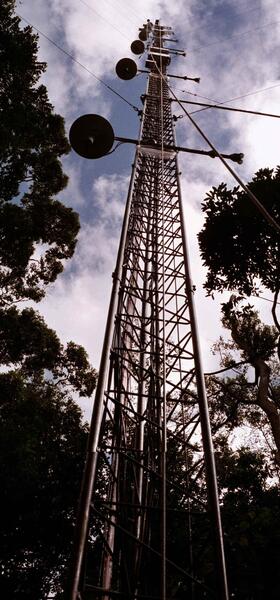Km67 Eddy Flux Tower Research Site
 This project has been funded by LBA, Large Scale Biosphere-Atmosphere Experiment in Amazonia. Each set of measurements includes explanatory information in a read.me file. Please read our statement on Fair Use, below, before proceeding to data. More data from the entire LBA project are available through the Beija-flor search engine at the LBA CPTEC data exchange.
This project has been funded by LBA, Large Scale Biosphere-Atmosphere Experiment in Amazonia. Each set of measurements includes explanatory information in a read.me file. Please read our statement on Fair Use, below, before proceeding to data. More data from the entire LBA project are available through the Beija-flor search engine at the LBA CPTEC data exchange.
FAIR USE
PLEASE READ CAREFULLY
The data contained on this site is freely available and we encourage others to use it. Kindly keep us informed of how you are using our data and of any publication plans. Please acknowledge the data source as a citation, or in the acknowledgments if the data have not yet been published. If we feel that we should be offered participation as authors, we will let you know and we assume that an agreement on such matters will be reached prior to publishing the data. If your work directly competes with our analysis we may ask that we have the opportunity to submit a manuscript before you submit one that uses unpublished data. These data may be updated or reprocessed from time to time, and it is your responsibility to insure that your publication contains the most recent revision of the data.
In order to maintain these measurements we periodically need to demonstrate progress to our sponsoring agencies. In addition to informing us of your plans, we kindly request that you help us by providing preprints and updates on publication status.
Ecological Measurements
Harvard University
Scott Saleska, Amy Rice, Lucy Hutyra, Elizabeth Hammond Pyle, Steven Wofsy
Ecological measurements of carbon exchange in the Tapajos National Forest, Para, Brazil, including biomass surveys, CWD surveys, tree growth and litter collections. All measurements are conducted in 1000 meter transects located west of the tower (see map). The two biomass surveys were conducted in July of 1999 and 2001 and the CWD survey was conducted in July 2001. Steel dendrometer bands were installed in February of 2000 and are measured every six weeks. Litter collections were initiated in July 2000: Nylon mesh baskets were laid out in random locations within transects, stratified by distance along the longitudinal axis. Results and analysis are reported in the publications and exhibition hall sections of this website; see the manuscript of Rice et al. "Carbon balance and vegetation dynamics of an old-growth tropical forest" for analysis and detailed explanation of methods.
Eddy Flux Data
Harvard University
Scott Saleska, Bruce Daube, Bill Munger, Steven Wofsy
Eddy fluxes of CO2 and H2O are measured at two levels (58m and 47m) using tower-mounted closed-path Licor 6262 analyzers and Campbell CSAT3 sonic anemometers. A third Licor gas analyzer measures (a) the CO2/H2O concentration profile (1 of 8 levels every 2 minutes) and (b) the instantaneous integrated canopy storage of CO2/H2O, using a design pulling air simultaneously through 8 inlets (once every 20 minutes). Comprehensive meteorological data (air temperature, PAR, net radiation, etc) are also included. Pressure and temperature of the Licor cells are controlled to 500 torr and 48 degrees C. Eddy licors are automatically zeroed every 2 hours and the profile licor every 20 minutes. All Licors are automatically calibrated with span gases (at 325, 400, and 475 ppm) every 6 hours.
See manuscript of Saleska, et al., "Carbon in Amazon forests: unexpected seasonal fluxes and disturbance-induced losses" and the supplement.
Santarem km67 CO concentrations
Harvard University
Bill Munger, Bruce Daube, Steven Wofsy
CO concentrations are measured in air drawn from above the canopy using a TEI 48CTL instrument modified for increased stability and sensitivity. Ambient air is dried to a dewpoint of 2C, and the cell pressure is maintained at 850 torr. The sensor is frequently zeroed by passing ambient air over a CO oxidation catalyst. The span is checked 4 times daily by sampling calibration gases at 100 and 500 ppb. Time in the file is given in UTC at the start of each half hour interval.